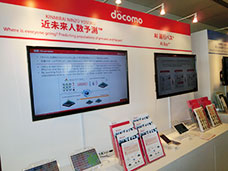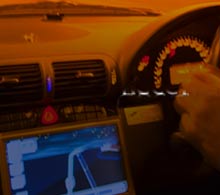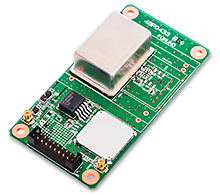Articles for ITS market Companies attempt new Vehicle-to-Infrastructure communications, including traffic volume measurements and vehicle positioning. -ITS Asia Pacific Forum in Fukuoka-
ITS Forum was held in Japan for the first time in 22 years. Countries and governments commended the city’s redesign.
The ITS Asia Pacific Forum was held on May 8 - 10, 2018 at Fukuoka International Conference Hall. ITS is an abbreviation for Intelligent Transport System and has an important role in the development of next-generation cars. Regarding the ITS Forum, there are three distinct sectors , International, Europe, and Asia Pacific. ITS related forums will be held in Japan for the first time in 22 years since Tokyo in 1995.
Many research institutes including governments, automobile manufacturers, auto parts manufacturers, IT-related manufacturers and universities in Asia and Oceania participated in exhibitions and lectures at the forum. The main items were many announcements on the automated driving and connected cars. On the technical side MaaS (Mobility as a Service) and the service business.
Also each countries government emphasized redesigning cities that they would support MaaS related policies in the future. Combining buses, trains, trams, bicycles, taxis, ride sharing and walking they aim to eliminate congestion in urban areas and reduce greenhouse gas emissions.
Utilizing sensor technologies to measure traffic volume and vehicle position are original ideas from ITS in the 1990s.
Japan was an early world leader in this technology.
In the background there are various service projects in which the public and private sectors collaborate.
For example, Japan introduced ETC (automatic toll collection system) utilizing DSRC (Narrow area communication) on highways nationwide. Japan also introduced VICS (Vehicle Information and Communication System) which provides traffic information such as traffic congestion to onboard units, initially in the Tokyo metropolitan area.
In addition Japan is home to the most popular in-vehicle car navigation system in the world and technology competition among companies has further advanced in-car navigation product development. This environment at the ITS Asia Pacific Forum attracted the attention of various sensor technology companies for installation on the road side and efforts to utilize them to measure traffic volume and position of the car.
The following summarizes each company.
PANASONIC
Vehicle-to-Infrastructure communication at intersection utilizing 60 GHz millimeter wave radar
In recent years millimeter wave radar has been used as part of ADAS (Advanced Driver Assistance System) for the purpose of irradiating vehicles from the onboard device.
On the other hand Panasonic is studying a concept model by installing a millimeter wave radar transmitter in the 60 GHz band on the intersection side and measuring the position of the traveling car. The mechanism is used to notify cars at the intersection of that information. According to a company official, because the frequency band is different from the millimeter wave radar for ADAS it does not interfere with millimeter wave radar radiated to the car from the intersection.Vehicle-to-Infrastructure communication using the 700 MHz band
Toyota will deploy the Vehicle-to-Infrastructure communication system using the 700 MHz band around the intersection positioned at the center for diffusion and also to inter-vehicle communication with pedestrian smartphones.Reverse running prevention system
This system utilizes a loop coil type sensor which has already been introduced for measuring traffic volume on the expressway. It will call attention to surrounding cars with an electronic road side display board when reverse running occurs. PANASONIC is now preparing it for introduction.
OKI Electric
A system that measures the position of a moving car using two radio receivers installed on the road side. Radio waves emitted from moving vehicles can use ETC / ETC 2.0, Wi-Fi, etc. They have been developing it for practical applications.
NEXCO West Japan
They have a Compact DSRC system compatible with ETC / ETC 2.0. It is intended for use in the vacation seasons such as New Year's holiday and summer holidays. It has been introduced initially in Kyushu and a part of expressway in Okinawa.
NTT DoCoMo
Mobile space measurement
Mobile space measurement is one of the services provided by NTT DoCoMo. Under the user agreement the user’s movements are visualized by obtaining location information of the mobile phone using GPS or Wi-Fi. By analyzing such data using artificial intelligence (AI) they developed a technology to predict human movement. In the future they will utilize it for setting routes such as bus, train, LRT (next generation tram line system) and formulating flight schedules. This service is also able to optimize the placement of temporary buses by predicting the movement of people before and after large scale events such as professional baseball games, soccer games and music concerts.AI bus
AI bus is a DoCoMo project that collaborates with a startup company at the Public Hakodate Mirai University. It is an attempt to get the best match between suppliers and users of small buses using a dedicated algorithm. They have tested and demonstrated at Tokyo and Fukushima. The demonstration in Fukuoka city was arranged as part of this ITS Asia Pacific Forum.
I hope that new business models related to ITS will continue to be generated from Japan into the worldwide markets by continuing the various sensing technologies mentioned in the article above.
Writer introduction

Mr. Kenji Momota Automotive journalist
His major is the world automotive industry and he is also familiar with the energy industry, IT and the aging society problem as the related fields. He acts around the world based in Japan and USA and writes for the general magazines, the technology journals and the automotive related media etc.
He is also commentator of motor race and world's motor show on TV program based on his career of the driver of Indy Racing League and NASCAR. In recent years, he has been covering about a paradigm shift from developed countries to developing countries, the motorized vehicle like EV and the telematics.
FURUNO ITS Journal
Click here for the latest articles after 2022 (in Japanese)2022
- The "realistic" self-driving roadmap shown by the Japanese government and a hands-on report on the latest Subaru EyeSight X
- Will FCVs (Fuel Cell Vehicles) Become Popular? ~New Movement in Toyota and Honda~
- The 'Complete' online sales of new cars start in Japan. Will this new way of buying cars take root?
- Many Firsts! On-Site Report from Tokyo Auto Salon 2022 - The author, who knows what goes on behind the scenes, looks back on 40 years of history. -
2021
- "Moving toward zero traffic fatalities for four-wheeled and two-wheeled vehicles globally in 2050" ~Experience on Honda's latest safety technologies~
- Tsuneishi Shipbuilding's building and DX, an exclusive visit to the main factory
- Japan's Smart City: New Moves toward Practical Use
- When will self-driving buses (service cars) be put to "full-scale" practical use?
- Utilization vehicle data during disasters
- Toyota-led Connected Technology to Transform Commercial Vehicle Business -From light trucks to large trucks and buses-
- Toyota enters the connected car "Personalization" business
- Japanese automakers' carbon-neutral strategies swept up in ESG investment
- Drive experience of the latest autonomous vehicle models and advanced driving support systems
- Will carbon neutrality accelerate the trend to strengthen LCA (Life Cycle Assessment)?
- Semiconductor shortage exposes realities of the automotive industry
- Online Autonomous Driving Contest Enhancing development of Human Resources
2020
- What happens to CASE when gas cars are banned in Japan?
- When will Flying Cars be launched?
- Expectation vs. reality:Autonomous Driving in Japan
- V2X, Becoming increasingly important in autonomous driving
- Technology of Subaru “EyeSight X”
- Lifestyle-oriented French cars gain popularity in Japan
- Human-oriented smart cities are wanted
- MaaS and CASE, how would automotive industry change after COVID-19?
- The beginning of virtualization era, triggered by COVID-19
- Trend of EV shift and consumer demands
- TOYOTA Press conference about ADAS - Releasing algorithm for "sudden acceleration suppression during attempted sudden acceleration" free of charge -
- The Japanese automotive industry in 2020 - 3 turning points -
- "Using a smartphone while driving" and "Level 3 automated driving"
2019
- Motor show business model is at a turning point - Tokyo Motor Show Report -
- Commercialization and monetization of MaaS - ITS World Congress Singapore Report -
- Android Automotive pays attention to V2X - Report from the Frankfurt Motor Show 2019 in Germany -
- Automobile Distribution Revolution and DCM (Data Communication Module)
- Connected business potential and newly proposed "eMaaS" by Honda
- 5G services for practical use are multiplying
- Connectivity technologies attracting attention due to frequent traffic accidents
- Shanghai Motor Show report -SUV, EV, Automated car & 5G-
- Drone Business roadmap and updates to Michibiki (Quasi-Zenith Satellite System)
- MaaS (Mobility as a Service) "town development." Full-scale promotion for a national project
- CES organizer states "Data Period in 2020s." Transformation of the Automotive Industry in CES, US "-CES2019 Report-"
- "Return to Origin" directed towards the age of change, automatic operation and connectivity
2018
- New proposal for Private Car Automated Driving Level and other Hot 5G Technology Topics
- Standardized EV charging infrastructure concerns in Europe, US, Japan and China - Kobe EVS 31 field report -
- Touring a pure car carrier and a test drive of the latest hybrid car
- Planning stage products are exhibited at the newly established visualized mobility service "TOYOTA MOBILITY SHOWROOM".
- Potential “Community Car-share” program promoted by local residents
- CES Asia Report 2108
- Companies attempt new Vehicle-to-Infrastructure communications, including traffic volume measurements and vehicle positioning. -ITS Asia Pacific Forum in Fukuoka-
- Geneva show in Switzerland. Flying cars and MaaS (Mobility as a Service) were hot topics.
- EV (Electric Vehicle) proposals by country
- MaaS competition through service mobilization, M & A and technical field collaboration is accelerating. - The CES 2018 Report -
2017
- Big data’s initiative and fight for the automotive industry. Cooperation among companies becomes increasingly important.
- Connected car and road-to-vehicle communication automatic operation
- ETC (Electronic Toll Collection) and ETC2.0. Current situation and projected future
- Rapid development of sharing economy
- Germany is first to recognize level 3 automated driving
- ITS EU 2017 Field Reports -Automatic Operation and the eCall-
- From Infotainment to ITS, the competitive area is spreading in the car big data industry.
- GTC (GPU Technology Conference) Report and the de facto standardization of AI (artificial intelligence)
- Renesas' new challenge! "e-AI Solution" and "Renesas Autonomy"
- The Automobile industry is shifting from a manufacturing industry to a service industry.
- The movement toward accident countermeasures for aging drivers in Japan
- Fusion of ride sharing and fully automated driving is advancing in the USA.
2016
- Overview of the Quasi-Zenith Satellite System (QZSS) and advancements toward full-scale practical use including the Tokyo Olympic Games - G-space EXPO 2016 report-
- Japan’s automated driving project "SIP-adus" will be a large demonstration experiment.
- The International Home Care & Rehabilitation Exhibition. There were many car manufactures with exhibits booths at this show.
- Japanese car manufacturers starting to concentrate on strengthening the ADAS system
- A new movement of legislation for autonomous cars
- Cyber Security and “AGL”, the new OS for automotive are hot topics in the connected car industry
- “High precision 3D map” the key future of autonomous car and pedestrian dead reckoning
- Chinese “BAT” is accelerating their business in the EV (Electric Vehicle) market
- Tesla's original connection to Taiwan and the new transportation system technologies.
- "The main topic" of the Geneva Motor Show was how to strengthen "pedestrian protection"
- The probe data business is getting more competitive
- Reporting directly from the 2016 CES show "Data services will soon become the main revenue source of automotive industry"
2015
- Do the automated driving systems need the GNSS (Global Navigation Satellite System) ?
- ETC Version 2.0 is coming soon. A new service was announced at the Tokyo Motor Show and the possibility that is could be used as a device for older drivers.
- "Connected Horizon" and "eHorizon". Germany's leading parts supplier accelerates strengthening of "Big Data" for business



 Fukuoka International Conference Hall is located at Fukuoka Port area.
Fukuoka International Conference Hall is located at Fukuoka Port area. Panasonic: Experiment in the 60 GHz band to explore new ways of utilizing millimeter wave radar.
Panasonic: Experiment in the 60 GHz band to explore new ways of utilizing millimeter wave radar. Panasonic: Inter-vehicle communications in the 700 MHz band where distribution is gradually spreading in Tokyo and Nagoya
Panasonic: Inter-vehicle communications in the 700 MHz band where distribution is gradually spreading in Tokyo and Nagoya Oki Electric: The characteristics correspond to various radio waves. The state of experiment is also published in this image.
Oki Electric: The characteristics correspond to various radio waves. The state of experiment is also published in this image. NEXCO West Japan: Their Compact DSRC system conforms to ETCETC 2.0.
NEXCO West Japan: Their Compact DSRC system conforms to ETCETC 2.0. NTT DoCoMo: Exploring a new business model for ITS as a major telecommunications carrier
NTT DoCoMo: Exploring a new business model for ITS as a major telecommunications carrier GPS/GNSS Receiver&Chips and Modules (positioning and timing)
GPS/GNSS Receiver&Chips and Modules (positioning and timing)